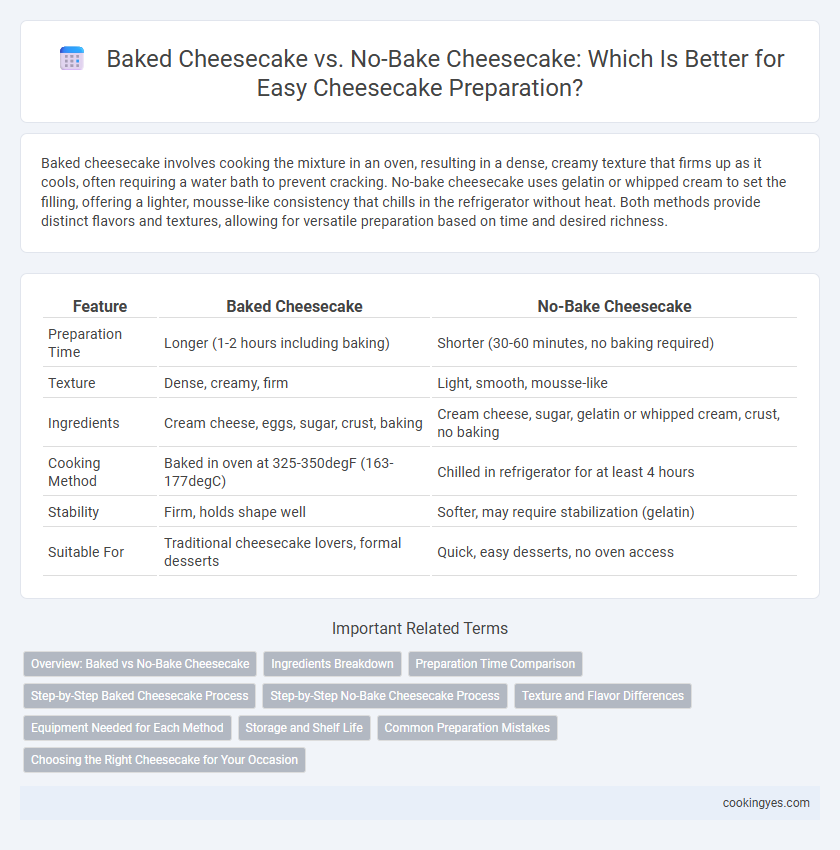Baked cheesecake involves cooking the mixture in an oven, resulting in a dense, creamy texture that firms up as it cools, often requiring a water bath to prevent cracking. No-bake cheesecake uses gelatin or whipped cream to set the filling, offering a lighter, mousse-like consistency that chills in the refrigerator without heat. Both methods provide distinct flavors and textures, allowing for versatile preparation based on time and desired richness.
Table of Comparison
| Feature | Baked Cheesecake | No-Bake Cheesecake |
|---|---|---|
| Preparation Time | Longer (1-2 hours including baking) | Shorter (30-60 minutes, no baking required) |
| Texture | Dense, creamy, firm | Light, smooth, mousse-like |
| Ingredients | Cream cheese, eggs, sugar, crust, baking | Cream cheese, sugar, gelatin or whipped cream, crust, no baking |
| Cooking Method | Baked in oven at 325-350degF (163-177degC) | Chilled in refrigerator for at least 4 hours |
| Stability | Firm, holds shape well | Softer, may require stabilization (gelatin) |
| Suitable For | Traditional cheesecake lovers, formal desserts | Quick, easy desserts, no oven access |
Overview: Baked vs No-Bake Cheesecake
Baked cheesecake features a dense, creamy texture achieved by cooking the cream cheese mixture in the oven, which enhances flavor depth through caramelization. No-bake cheesecake relies on gelatin or other stabilizers to set the filling in the refrigerator, resulting in a lighter, mousse-like consistency and quicker preparation time. Both methods offer distinct textures and preparation techniques, catering to varying taste preferences and skill levels in cheesecake making.
Ingredients Breakdown
Baked cheesecake typically contains cream cheese, eggs, sugar, and heavy cream, which lend it a dense, rich texture due to the eggs setting during baking. No-bake cheesecake relies on cream cheese, sugar, and whipped cream or gelatin to achieve a lighter, mousse-like consistency without the need for ovens. The absence of eggs in no-bake versions results in a creamier texture, while the presence of eggs and heat in baked cheesecake ensures firmness and a slightly caramelized crust.
Preparation Time Comparison
Baked cheesecake typically requires a longer preparation time due to baking and cooling, often taking several hours to set properly. No-bake cheesecake is faster to prepare, usually requiring only refrigeration for a few hours to firm up. Choosing between the two depends on time availability and desired texture, with no-bake offering convenience and baked cheesecake providing a denser, creamier consistency.
Step-by-Step Baked Cheesecake Process
Baked cheesecake requires precise temperature control and gradual baking to achieve a creamy, dense texture without cracks, starting with mixing cream cheese, sugar, and eggs before baking in a water bath to ensure even heat distribution. The crust is typically made from crushed graham crackers combined with melted butter and pressed firmly into a springform pan, then baked briefly to set. Cooling the cheesecake slowly, often overnight in the refrigerator, is crucial for developing its signature rich texture and flavor.
Step-by-Step No-Bake Cheesecake Process
No-bake cheesecake preparation involves mixing cream cheese, sugar, and whipped cream into a smooth filling without baking, allowing it to set in the refrigerator for at least 4 hours or overnight. The crust typically consists of crushed graham crackers combined with melted butter, pressed firmly into the pan before adding the filling. This method ensures a creamy texture and a quicker, simpler preparation compared to the traditional baked cheesecake.
Texture and Flavor Differences
Baked cheesecake features a dense, creamy texture with a rich, caramelized flavor derived from the Maillard reaction during baking, offering a slightly firm yet smooth bite. No-bake cheesecake presents a lighter, mousse-like texture with a fresh, tangy taste, often achieved through whipped cream or gelatin stabilization without heat exposure. The choice between baked and no-bake methods significantly impacts flavor depth and mouthfeel, catering to distinct dessert preferences.
Equipment Needed for Each Method
Baked cheesecake requires an oven, springform pan, mixing bowls, and often a water bath setup to ensure even baking and prevent cracks. No-bake cheesecake demands minimal equipment, typically just a mixer, refrigerator space for chilling, and a springform or regular pan for setting the dessert. The choice between baked and no-bake cheesecake depends on available kitchen tools and desired preparation time.
Storage and Shelf Life
Baked cheesecake requires refrigeration and generally has a shelf life of about 5 to 7 days, maintaining its creamy texture and flavor when stored properly in an airtight container. No-bake cheesecake, being less dense and often made with cream cheese or whipped toppings, also needs to be refrigerated but usually lasts about 3 to 5 days before the texture begins to degrade. Both types should be kept at consistent cold temperatures to prevent spoilage and preserve the best taste and quality.
Common Preparation Mistakes
Baked cheesecake requires careful temperature control to avoid cracks caused by overbaking or sudden cooling, while no-bake cheesecake often suffers from insufficient chilling, resulting in a runny texture. Overmixing batter in both types can incorporate excess air, leading to a dense or crumbly consistency. Using low-quality cream cheese or failing to properly soften it causes lumps and uneven texture in the final cheesecake.
Choosing the Right Cheesecake for Your Occasion
Baked cheesecake, known for its dense and rich texture due to the slow baking process, suits formal occasions or celebrations that require a classic dessert with a firm structure. No-bake cheesecake offers a lighter, creamier texture, perfect for casual gatherings or warm weather events, as it requires refrigeration rather than baking, making preparation quicker and simpler. Selecting between baked and no-bake cheesecake depends on the desired texture, preparation time, and temperature control needed for your specific event.
Baked cheesecake vs no-bake cheesecake for preparation Infographic

 cookingyes.com
cookingyes.com